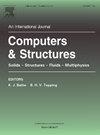基于贝叶斯神经网络的结构可靠度概率密度演化方法
IF 4.8
2区 工程技术
Q1 COMPUTER SCIENCE, INTERDISCIPLINARY APPLICATIONS
引用次数: 0
摘要
本文提出了一种基于贝叶斯神经网络(BNN)的结构响应概率密度演化的结构可靠度估计方法。这种方法的优点是概率空间与物理空间解耦,这有助于静态和动态情况下的可靠性估计。在动态系统中,传统的Fokker-Planck-Kolmogorov方程与物理空间耦合,求解困难,问题更为突出。因此,概率密度函数的数值解需要大量的代表性点才能达到足够的精度,这对于复杂系统来说通常是计算昂贵的。这个问题是使用贝叶斯神经网络来解决的,贝叶斯神经网络具有固有的建模任意不确定性和认知不确定性的能力。为了说明所提出的基于bnn的概率密度评估,给出了六个不同的问题,分别是一维非线性振子、Duffing振子、复合梁、门式框架、平面桁架和空间桁架。前两个例子通过与Fokker-Planck-Kolmogorov方程、基于euler - maruyama的解和Monte Carlo模拟的结果比较,证明了所提方法的准确性。本研究的数值结果表明,所提出的基于bnn的概率密度评估可以在不牺牲精度的情况下使用相对较少的代表性点来预测故障的可能性,与模拟或其他传统方法相比,可以减少计算成本。这种方法对于通过对pdf的完整描述来进行可靠性估计更为通用,而不是解决涉及随机变量的优化问题。本文章由计算机程序翻译,如有差异,请以英文原文为准。
Bayesian neural network based probability density evolution approach for efficient structural reliability analysis
This study presents a unique proposal for the estimation of structural reliability using a Bayesian neural network (BNN)-based probability density evolution of the structural response. The advantage of this approach is that the probability space is decoupled from the physical space, which helps in reliability estimation for both static and dynamic cases. The problem is more prominent for dynamic systems where the traditional Fokker–Planck–Kolmogorov equation is coupled with the physical space, making it difficult to solve. Thus, a significant number of representative points are required for the numerical solution of the probability density function to achieve adequate accuracy, which is often computationally expensive for complex systems. This issue is addressed using a Bayesian neural network, which has an inherent ability to model aleatoric as well as epistemic uncertainty. To illustrate the proposed BNN-based probability density evaluation, six different problems are presented, which are a one-dimensional nonlinear oscillator, a Duffing oscillator, a composite beam, a portal frame, a planar truss, and a space truss. The first two examples are utilized to show the accuracy of the proposed method by comparing the results with the Fokker–Planck–Kolmogorov equation, the Euler–Maruyama-based solution, and Monte Carlo simulation. The numerical results of this study show that the proposed BNN-based probability density evaluation can predict the likelihood of failure using relatively few representative points without sacrificing accuracy, leading to a reduction in computational costs when compared to simulation or other traditional approaches. This approach is more generic for reliability estimation through a complete description of pdf as opposed to solving an optimization problem involving random variables.
求助全文
通过发布文献求助,成功后即可免费获取论文全文。
去求助
来源期刊

Computers & Structures
工程技术-工程:土木
CiteScore
8.80
自引率
6.40%
发文量
122
审稿时长
33 days
期刊介绍:
Computers & Structures publishes advances in the development and use of computational methods for the solution of problems in engineering and the sciences. The range of appropriate contributions is wide, and includes papers on establishing appropriate mathematical models and their numerical solution in all areas of mechanics. The journal also includes articles that present a substantial review of a field in the topics of the journal.
 求助内容:
求助内容: 应助结果提醒方式:
应助结果提醒方式:


